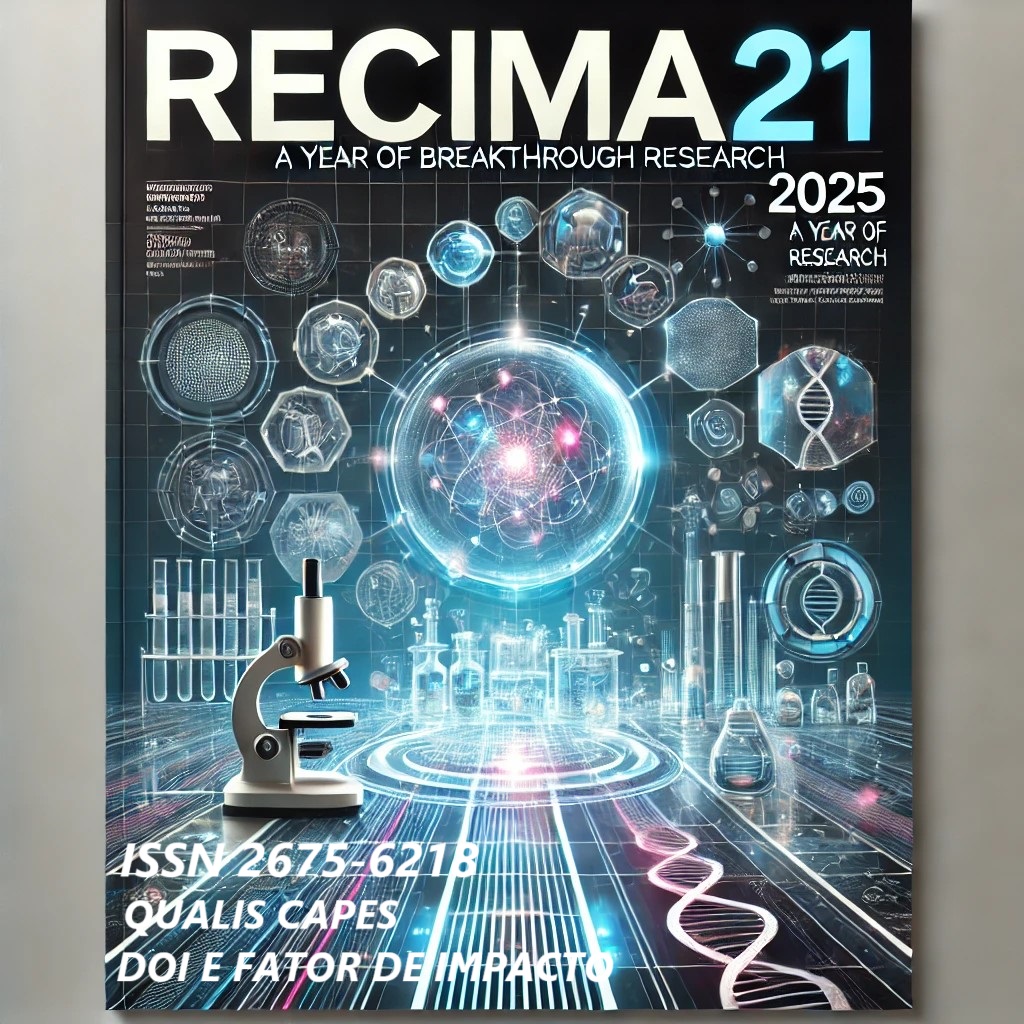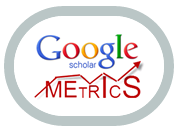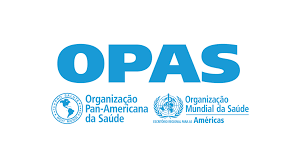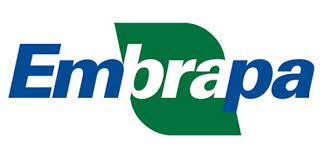ENCERAMENTO DIGITAL NA ODONTOLOGIA: APLICAÇÕES E BENEFÍCIOS CLÍNICOS
DOI:
https://doi.org/10.47820/recima21.v6i8.6719Palavras-chave:
Desenho Assistido por Computador; Impressão Tridimensional; Reabilitação Bucal; OdontologiaResumo
O enceramento digital é um aparato funcional atuante no planejamento e na execução de diferentes tratamentos dentários de modo dinâmico. Objetivo: Revisar a literatura sobre aplicações e benefícios clínicos do enceramento digital, avaliando sua eficiência e precisão em tratamentos odontológicos reabilitadores estéticos e funcionais. Metodologia: Realizou-se uma revisão integrativa em base de dados como PUBMED, BVS, BBO e Google Acadêmico, aplicando critérios específicos de inclusão e de exclusão para artigos publicados entre 2019 e 2024. Resultados: O enceramento digital demonstrou ser amplamente utilizado em áreas como educação em odontologia, dentística, próteses e materiais dentários, com vantagens significativas sobre métodos convencionais em termos de precisão e eficiência. Considerações: O enceramento digital é uma ferramenta promissora em odontologia, melhorando a previsibilidade e personalização dos tratamentos, embora existam variações nos resultados entre diferentes sistemas CAD/CAM, demandando maior conhecimento técnico dos profissionais.
Downloads
Referências
1. Revilla-León M, Besné-Torre A, Sánchez-Rubio JL, et al. Digital tools and 3D printing technologies integrated into the workflow of restorative treatment: a clinical report. J Prosthet Dent. 2019 jan;121(1):3-8. doi: 0.1016/j.prosdent.2018.02.020. DOI: https://doi.org/10.1016/j.prosdent.2018.02.020
2. De Cristina Mocelin R, Penteado MM, Pierre FZ, et al. Assessment of patient and dentist preference between conventional and digital diagnostic waxing. Int J Esthet Dent. 2021 ago;16(3):300-309.
3. De Holanda Neto DR, Campos DS, Freitas RHB, et al. Planejamento digital do sorriso. Rev Cuba Estomatol. 2020 set; 57(3):e3117.
4. Rossi NR, Silva JFG, Rodrigues MR, et al. Aplicabilidade do digital smile design em reabilitações estéticas: revisão de literatura. J Dent Public Health Salvador. 2020 Dez;11(2):139-147Doi: 10.17267/2596-3368dentistry.v11v2.2942 DOI: https://doi.org/10.17267/2596-3368dentistry.v11i2.2942
5. Molina WPC, Caisaguano JWR, Núnez MAR. Utilidad de la tecnología CAD/CAM en la fabricación de prótesis dentales. MediSur. 2023 nov;21(6):1305-1311.
6. Moreira DS, Paixão JS, Magalhães JM, et al. Fluxo digital-do planejamento a execução da reabilitação oral estética: revisão sistemática. Res Soc Dev. 2023 abr;12(5):e4812540714-e4812540714. doi: http://dx.doi.org/10.33448/rsd-v12i5.40714 DOI: https://doi.org/10.33448/rsd-v12i5.40714
7. Souza MTD, Silva MDD, Carvalho RD (2010) Revisão Integrativa: o que é e como fazer. Eistein (São Paulo). 2010 Mar-Jan;8(1 Pt 1):102-106. DOI: https://doi.org/10.1590/s1679-45082010rw1134
8. Elgreatly A, Mahrous A, Clark WA, et al. Students’ perception of digital waxing software for dental anatomy education. J Oral Sci. 2022 abr 1;64(2):178-180. doi: doi.org/10.2334/josnusd.22-0004 DOI: https://doi.org/10.2334/josnusd.22-0004
9. Chiang H, Staffen A, Abdulmajeed AA, et al. Effectiveness of CAD/CAM technology: a self‐assessment tool for preclinical waxing exercise. Eur J Dent Educ. 2021 fev;25(1):50-55. doi: 10.1111/eje.12576 DOI: https://doi.org/10.1111/eje.12576
10. Karl E, Siddanna GD, Mantesso A. Preclinical assessment of Class IV proximal contacts following different teaching strategies. Eur J Dent Educ. 2022 maio;26(2):409-415. doi: 10.1111/eje.12717. DOI: https://doi.org/10.1111/eje.12717
11. No-Cortes J, Son A, Ayres AP, et al. Effect of varying levels of expertise on the reliability and reproducibility of the digital waxing of single crowns: A preliminary in vitro study. J Prosthet Dent. 2022 jan;127(1):128-133. DOI: https://doi.org/10.1016/j.prosdent.2020.10.007
12. Piedra-Cascón W, Hsu VT, Revilla-León M. Facially driven digital diagnostic waxing: new software features to simulate and define restorative outcomes. Current Oral Health Reports. 2019 dez;6(4):284-294. DOI: https://doi.org/10.1007/s40496-019-00233-6
13. Georgieva K, Kanlieva T. Digital diagnostic wax-up as a part of esthetic dental treatment in front area: A case report. International Bulletin of Otorhinolaryngology. 2022 abr;18(4):6-12. DOI: https://doi.org/10.14748/orl.v18i4.9064
14. Piedra-Cascón W, Fountain J, Att W, et al. 2D and 3D patient's representation of simulated restorative esthetic outcomes using different computer‐aided design software programs. J Esthet Restor Dent 2021 jan;33(1):143-151. DOI: https://doi.org/10.1111/jerd.12703
15. Dos Santos MMTC, Relvas A, Vieira B, et al. DSD and CAD/CAM integration in the planning and execution of an oral rehabilitation procedure: A case report. Clin Lab Res Dent. 2019 mar. doi: https://doi.org/10.11606/issn.2357-8041.clrd.2019.151911 DOI: https://doi.org/10.11606/issn.2357-8041.clrd.2019.151911
16. De Souza Lima RX, Vieira do Nascimento JJ, Duarte Carvalho R, et al. Facetas diretas em resina composta utilizando o fluxo digital para planejamento: relato de caso. Rer Ciência Plural. 2023 abr;9(1):1-14. DOI: https://doi.org/10.21680/2446-7286.2023v9n1ID29634
17. Ahmed WM, Azhari AA, Sedayo L, et al. Mapping the landscape of the digital workflow of esthetic veneers from design to cementation: a systematic review. Dent J (Basel). 2024 jan;12(2):28. doi: https://doi.org/10.3390/dj12020028 DOI: https://doi.org/10.3390/dj12020028
18. Luo T, Li J, Xie C, et al. Accuracy of three digital waxing–guided trial restoration protocols for controlling the depths of tooth preparation for ceramic veneers. J Prosthet Dent. 2022 fev; 17;131(1):56–63. DOI: https://doi.org/10.1016/j.prosdent.2021.12.029
19. Silva BP, Stanley K, Gardee J. Laminate veneers: Preplanning and treatment using digital guided tooth preparation. J Esthet Restor Dent. 2020 mar;32(2):150-160. doi: 10.1111/jerd.12571 DOI: https://doi.org/10.1111/jerd.12571
20. Souza WLR, Coelho Segundo ART, Resente TH, et al. Laminados Oclusais CAD-CAM e DSD-Natural Restoration para a Reabilitação da Biocorrosão. RNO. 2020 jul;47(2):26-34. doi: https://doi.org/10.29327/25149.47.2-3 DOI: https://doi.org/10.29327/25149.47.2-3
21. Da Silva CGP, Cezar MC, Burmann PFP. Harmonização do sorriso: aliando ortodontia e estética. RFO. UPF 2023 ago;27(1):1-13. doi: http://dx.doi.org/10.5335/rfo.v27i1.15171 DOI: https://doi.org/10.5335/rfo.v27i1.15171
22. Espinel-Arteaga K, Parise-Vasco JM, Chiluisa-Muso RA, et al. Rehabilitación estética con coronas de resina personalizadas utilizando encerado digital en paciente pediátrico: informe de caso. Odontol Vital. 2022 jun;36:64-75. DOI: https://doi.org/10.59334/ROV.v1i36.488
23. Benic GI, Sailer I, Zeltner M, et al. Randomized controlled clinical trial of digital and conventional workflows for the fabrication of zirconia-ceramic fixed partial dentures. Part III: marginal and internal fit. J Prosthet Dent. 2019 mar;121(3):426-431. DOI: https://doi.org/ 10.1016/j.prosdent.2018.05.014. DOI: https://doi.org/10.1016/j.prosdent.2018.05.014
24. Dimitrova M, Vlahova A, Kalachev Y, et al. Recent advances in 3D printing of polymers for application in prosthodontics. Polymers. 2023 nov;15(23):4525. DOI: https://doi.org/10.3390/polym15234525 DOI: https://doi.org/10.3390/polym15234525
25. Guachetá L, Stevens CD, Cardona JAT, et al. Comparison of marginal and internal fit of pressed lithium disilicate veneers fabricated via a manual waxing technique versus a 3D printed technique. J Esthet Restor Dent. 2022 jun;34(4):715-720. doi: 10.1111/jerd.12675 DOI: https://doi.org/10.1111/jerd.12675
26. Mattevi GS, Linden MSS, De Carli JP, Rocha OS, de Oliveira KM. Precisāo das Impressões Digital e Convencional na Prótese sobre Implante: uma revisão de literatura. Revista da Faculdade de Odontologia-UPF. 2025;30(1):1-17. DOI: http://dx.doi.org/10.5335/rfo.v30i1.16696 DOI: https://doi.org/10.5335/rfo.v30i1.16696
Downloads
Publicado
Licença
Direitos de Autor (c) 2025 RECIMA21 -Revista Científica Multidisciplinar - ISSN 2675-6218

Este trabalho encontra-se publicado com a Licença Internacional Creative Commons Atribuição 4.0.
Os direitos autorais dos artigos/resenhas/TCCs publicados pertecem à revista RECIMA21, e seguem o padrão Creative Commons (CC BY 4.0), permitindo a cópia ou reprodução, desde que cite a fonte e respeite os direitos dos autores e contenham menção aos mesmos nos créditos. Toda e qualquer obra publicada na revista, seu conteúdo é de responsabilidade dos autores, cabendo a RECIMA21 apenas ser o veículo de divulgação, seguindo os padrões nacionais e internacionais de publicação.













